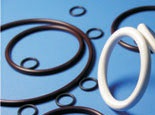-
National consultation hotline:
13590252450 / 18676388050


Time:2024-05-09 Preview:1
Hello everyone, I am the editor. Today I will introduce you to fluororubber. The following content is compiled by the editor and the relevant content is for reference only.

Good stability
Fluororubber has a high degree of chemical stability and is the best medium-resistant among all elastomers. Type 26 fluororubber is resistant to petroleum-based oils, diester oils, silicone ether oils, silica oils, inorganic acids, most organic and inorganic solvents, and drugs. It is only not resistant to low-molecular ketones, ethers, esters, amines, ammonia, hydrofluoric acid, chlorosulfonic acid, and phosphoric acid hydraulic oils. The medium performance of type 23 fluororubber is similar to that of type 26, and it is more unique. It is better than type 26 in resistant to strong oxidizing inorganic acids such as fuming nitric acid and concentrated sulfuric acid. Its volume expansion is only 13%~15% after being immersed in 98% HNO3 for 27 days at room temperature.
High temperature resistance
The high temperature resistance of fluororubber is the same as that of silicone rubber, which can be said to be the best among current elastomers. 26-41 fluororubber can be used for a long time at 250℃ and for a short time at 300℃; 246 fluororubber is better in heat resistance than 26-41. The physical properties of 26-41 after 300℃×100 hours of air heat aging are comparable to those of 246 after 300℃×100 hours of hot air aging. Its elongation at break can be maintained at about 100%, and its hardness is 90~95 degrees. 246 maintains good elasticity after 16 hours of hot air aging at 350℃, and maintains good elasticity after 110 minutes of hot air aging at 400℃. After 110 minutes of hot air aging at 400℃, the elongation of the rubber containing spray carbon black, thermal cracking carbon black or carbon fiber increases by about 1/2~1/3, and the strength decreases by about 1/2, but still maintains good elasticity. 23-11 type fluororubber can be used for a long time at 200℃ and for a short time at 250℃.
Aging resistance
Fluororubber has excellent weather aging resistance and ozone resistance. It is reported that the performance of VitonA developed by DuPont is still satisfactory after ten years of natural storage, and there is no obvious cracking after 45 days in air with an ozone concentration of 0.01%. Type 23 fluororubber also has excellent weather resistance and ozone resistance.
Vacuum performance
Type 26 fluororubber has excellent vacuum performance. The vacuum degassing rate of the vulcanized rubber with the basic formula of 246 fluororubber is only 37×10-6 Torr/s. cm2. Type 246 fluororubber has been successfully used under vacuum conditions of 10-9 Torr.
Mechanical properties
Fluororubber has excellent physical and mechanical properties. Type 26 fluororubber generally has a strength between 10~20MPa, a tear elongation between 150~350%, and a tear strength between 3~4KN/m. Type 23 fluororubber has a strength between 15.0~25MPa, an elongation between 200%~600%, and a tear strength between 2~7MPa. Generally, the compression permanent deformation of fluororubber at high temperature is large, but if compared under the same conditions, such as the compression permanent deformation at 150℃ for the same time, both butyl rubber and chloroprene rubber are larger than 26-type fluororubber, and the compression deformation of 26-type fluororubber at 200℃×24 hours is equivalent to the compression deformation of butyl rubber at 150℃×24 hours.
Electrical properties
23-type fluororubber has better electrical properties and lower hygroscopicity than other elastomers, and can be used as a better electrical insulation material. 26-type rubber can be used at low frequency and low pressure.
Low permeability
Fluororubber has a relatively large solubility in gas, but its diffusion rate is relatively low, so the overall permeability is also small. It is reported that the permeability of 26-type fluororubber to oxygen, nitrogen, helium, and carbon dioxide at 30℃ is equivalent to that of butyl rubber and butyl rubber, and is better than chloroprene rubber and natural rubber.
Low temperature performance
The low temperature performance of fluororubber is not good, which is due to its own chemical structure, such as Tg>0℃ of 23-11 type. The low-temperature performance of fluororubber in actual use is usually expressed by brittle temperature and compression cold resistance coefficient. The formula of the rubber compound and the shape of the product (such as thickness) have a great influence on the brittle temperature. For example, if the amount of filler in the formula increases, the brittle temperature will sensitively deteriorate. If the thickness of the product increases, the brittleness will also sensitively deteriorate.
Radiation resistance
The radiation resistance of fluororubber is one of the poorer ones among elastomers. After radiation, type 26 rubber shows a cross-linking effect, while type 23 fluororubber shows a cracking effect. The performance of type 246 fluororubber changes dramatically at a dose of 5×107 gallons under room temperature radiation in air. Under 1×107 gallons, the hardness increases by 1~3 degrees, the strength decreases by less than 20%, and the elongation decreases by 30%~50%. Therefore, it is generally believed that type 246 fluororubber can withstand 1×107 gallons, and the limit is 5×107 gallons.
If you want to know more about the industry information of fluororubber, please log in to our official website and we will bring you more practical tips.